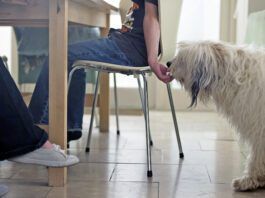TTouch Practitioners Explain Canine “Body Wrapping”
Body wrapping" dogs looks kooky
Living with a Difficult Dog
By your own standards, your dog’s life may not seem all that stressful – after all, he doesn’t have bills to pay, does he? But when you apply the more scientific definition of the word – anything that alarms or excites him, triggering his sympathetic nervous system into action and flooding him with the “fight or flight” chemicals adrenaline and noradrenaline – you may be able to see how many seemingly unrelated things in his environment actually contribute to his “misbehavior.”
Dealing With Submissive Urination
Submissive urination is a vexing challenge with some puppies and young dogs. Most grow out of it eventually, but in the meantime, how can you help your pup put a cork in it? In the canine world, when one dog wants to show deference to another, more dominant dog, he may urinate as a sign of submission. The more threatened he feels, the more likely he is to urinate. This is an involuntary reaction, an instinctive behavior that all dogs are born “knowing” how and when to exhibit. In a pack of dogs, this programmed behavior is a valuable survival mechanism. Puppies are extremely vulnerable to the wrath of adult dogs in the pack, and built-in submissive responses signal normal adult dogs to automatically shut off the aggression, thus keeping puppies from being hurt.
Upper-Level Management
Garbage-raiding, counter-surfing, barking at passers-by ... How do you train your dog to stop his bad behavior? Often, the answer isn’t a matter of training at all!
Managing Canine Behavior
September can be confusing for dogs who have grown accustomed to the constant attention of human friends over the summer. This is an especially difficult time for puppies, acquired in June, who have never been left alone for as many as eight to 10 hours a day. Suddenly the pup is abandoned by the pack, and an animal who would rarely be alone for long periods in his natural environment is left to his own devices for several hours at a time. Small wonder that this is the time when housetraining commonly breaks down, destructive behavior erupts, human tempers flare, and dogs are either banished to backyard isolation, returned to breeders, or dumped at animal shelters.
Dogs With An Unhealthy Fear of Storms and Loud Noises
Many behaviorists and dog trainers believe that puppies go through a so-called fear imprinting" period sometime between the ages of eight to 20 weeks
Is Your Dog Afraid of Thunder?
Everyone knows a thunderstorm horror story. A terrified dog leaps off a balcony or breaks through a plate glass window before jumping a fence, running into traffic, and meeting an unhappy fate. Or the animal simply disappears and is never seen again. More common and just as distressing are the panic attacks that overcome stay-at-home dogs when thunder roars or the neighbors light firecrackers. Conventional veterinary medicine treats thunderstorm and other noise phobias with powerful tranquilizers or psychoactive drugs, none of which cure the patient and all of which have adverse side effects.
Hannah’s Change of Heart
Hannah was a normal, healthy Labrador Retriever puppy: happy, boisterous, playful, and always willing to eat. Hannah’s owner, Connecticut resident Anne Hassett, bought Hannah when the pup was seven weeks old. Hassett trained, socialized, and loved the golden pup. A field-line Labrador, Hannah hunted on the weekends and enjoyed the comfy life of a companion Lab weekdays. Hannah was well known in hunting circles for her steady, easy-going temperament, the coveted hallmark of the Labrador breed. Hassett considered breeding her, and had the dog examined and tested for genetic diseases.
When Your Well-Trained Dog Turns Aggressive – Act Fast!
I first met Lucy at my local monthly “My Dog Can Do That” competition in January of 1998, at the SPCA in Monterey, California. She was easy to spot – a merle Great Dane with lovely natural ears, who literally towered above the competition. Lucy was attentive, responsive, performed even the most advanced MDCDT behaviors with ease, and consistently placed in the ribbons. It surprised me, then, when a few months later I heard Lucy had started threatening humans, and her aggression was escalating. This was not appropriate behavior for any dog, but particularly disturbing in one of Lucy’s size, with her potential for causing serious harm.
Trying To Ease Your Dog’s Stress
Stress. Everyone knows what it feels like. Tight shoulders. Headache. Insomnia. Upset stomach. Everyone knows what can trigger it. Rush hour traffic. Deadlines. An insensitive boss. A toddler having a day of tantrums, unexpected bills, or taxes. We also know that too much stress can actually make us ill. Ulcers and high blood pressure are prime examples. A recent study noted that 19 percent of employees who call in sick on any particular day do so because they simply felt they needed a day off.













